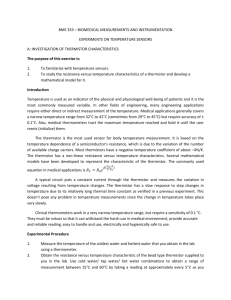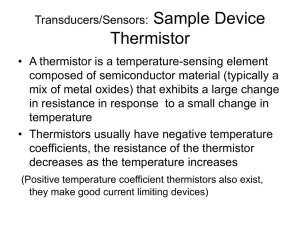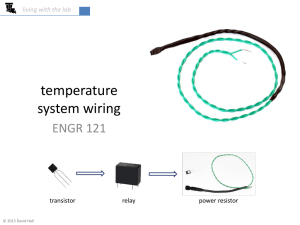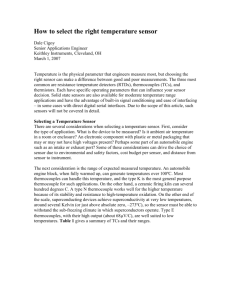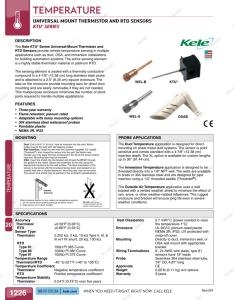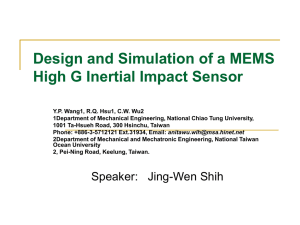2014 Temperature Lecture V1
advertisement
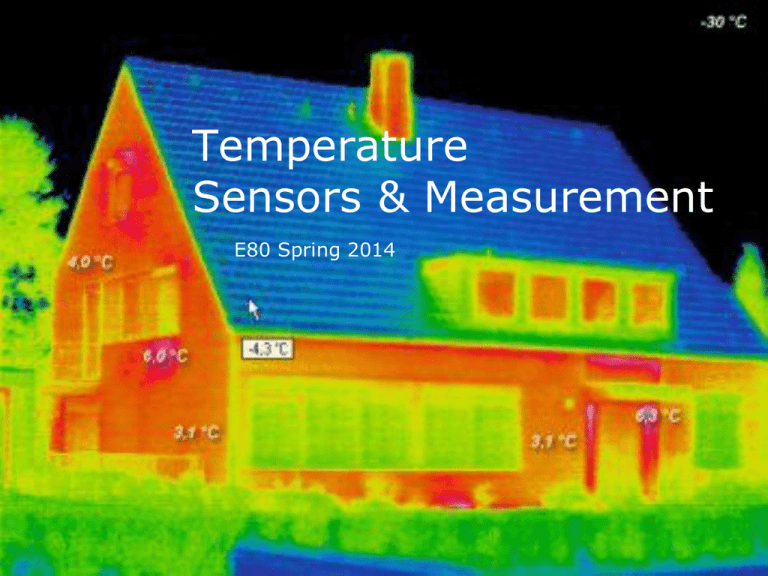
Temperature Sensors & Measurement E80 Spring 2014 Contents Why measure temperature? Characteristics of interest Types of temperature sensors – – – – 1. Thermistor 2. RTD Sensor 3. Thermocouple 4. Integrated Silicon Linear Sensor Sensor Calibration Signal Conditioning Circuits (throughout) Why Measure Temperature? Temperature measurements are one of the most common measurements... Temperature corrections for other sensors – e.g., strain, pressure, force, flow, level, and position many times require temperature monitoring in order to insure accuracy. Important Properties? Sensitivity Temperature range Accuracy Repeatability Relationship between measured quantity and temperature Linearity Calibration Response time Types of Temperature Sensors? Covered 1. Thermistor Ceramic-based: oxides of manganese, cobalt , nickel and copper 2. Resistive Temperature Device RTD Metal-based : platinum, nickel or copper 3. Thermocouple junction of two different metals 4. Integrated Silicon Linear Sensor Si PN junction of a diode or bipolar transistor Not Covered 5. Hot Wire Anemometer 6. Non-Contact IR Single Sensor 7. IR Camera Part I Thermistor High sensitivity Inexpensive Reasonably accurate Lead resistance ignored Glass bead, disk or chip thermistor Typically Negative Temperature Coefficient (NTC), – PTC also possible nonlinear relationship between R and T Thermistor resistance vs temperature Simple Exponential Thermistor Model RT = R0 x exp[ β(1/T -1/T0)] – RT is the thermistor resistance (Ω). – T is the thermistor temperature (K) – Manufacturers will often give you R0, T0 and an average value for β • β is a curve fitting parameter and itself is temperature dependent. Simple Exponential Thermistor Model Usually T0 is room temp 25oC = 298oK – So R0 = R25 RT = R25 x exp[β(1/T – 1/298)] – where β ≈ ln (R85/R25) /(1/358-1/298) Not very accurate but easy to use Better Thermistor model Resistance vs temperature is non-linear but can be well characterised by a 3rd order polynomial ln RT = A + B / T +C / T2 + D / T3 where A,B,C,D are the characteristics of the material used. Inverting the equation The four term Steinhart-Hart equation T = [A1 +B1 ln(RT/R0)+C1 ln2(RT/R0)+D1ln3(RT/R0)]-1 Also note: • • • • Empirically derived polynomial fit A, B, C & D are not the same as A1, B1 , C1 & D1 Manufacturers should give you both for when R0 = R25 C1 is very small and sometime ignored (the three term SH eqn) http://www.eng.hmc.edu/NewE80/PDFs/VIshayThermDataSheet.pdf Thermistor Calibration 3-term Steinhart-Hart equation T = [A1 +B1 ln(RT/R0)+D1ln3(RT/R0)]-1 How do we find A1, B1 and D1? Minimum number of data points? Linear regression/Least Squares Fit (Lecture 2) Thermistor Problems: Self-heating You need to pass a current through to measure the voltage and calculate resistance. Power is consumed by the thermistor and manifests itself as heat inside the device – P = I2 RT – You need to know how much the temp increases due to self heating by P so you need to be given θ = the temperature rise for every watt of heat generated. Heat flow Very similar to Ohms law. The temperature difference (increase or decrease) is related to the power dissipated as heat and the thermal resistance. ΔC=Pxθ – P in Watts – θ in oC /W Self Heating Calculation ΔoC = P x θ = (I2 RT) θ Device to ambient Example. – I = 5mA – RT = 4kΩ – θDevice to ambient = 15 oC /W Δ oC = Self Heating Calculation ΔoC = P x θ = (I2 RT) θ Device to ambient Example. – I = 5mA – RT = 4kΩ – θDevice to ambient = 15 oC /W ΔoC = (0.005)2 X 4000 X 15 = 1.5 C Linearization Techniques Current through Thermistor is dominated by 10k Ω resistor. Linearization of a 1O k-Ohm Thermistor This plot Ti = 50 0C, Ri = 275 Ω Linearization techniques Part II RTD Accurate & Stable Reasonably wide temperature range More Expensive Positive temperature constant Requires constant currant excitation Smaller resistance range – Self heating is a concern – Lead wire resistance is a concern More complicated signal conditioning pRTD, cRTD and nRTD The most common is one made using platinum so we use the acronym pRTD Copper and nickel as also used but not as stable Linearity: The reason RTDs are so popular RTD are almost linear Resistance increases with temperature (+ slope) RT = R0(1+ α)(T –T0) Recognized standards for industrial platinum RTDs are – IEC 6075 and ASTM E-1137 α = 0.00385 Ω/Ω/°C Measuring the resistance needs a constant current source Read AN 687 for more details (e.g. current excitation circuit): http://ww1.microchip.com/downloads/en/AppNotes/00687c.pdf http://www.control.com/thread/1236021381 on 3-wire RTD With long wires precision is a problem Two wire circuits, Three wire circuits and Four wire circuits. Two wire: lead resistances are a problem Power supply connected here No current flows in here The IDAC block is a constant current sink Three wire with two current sinks Four wire with one current sink. 4 wire with precision current source Mathematical Modelling the RTD The Callendar-Van Dusen equation RT = R0 (1 + A T + B T2 + C T3(T-100) = R0 (1+ A T + B T2) – where R0 is the resistance at T0 = 0 oC and For platinum A = 3.9083 x e-3 oC-1 B = -5.775 x e-7 oC-2 C = -4.183 x e-12 oC-4 for T < 0 oC for T > 0 oC Experimentally Derive temperature (+/-) from the measured resistance. Easiest way is to construct a Look-Up table inside LabView or your uP Precision, accuracy, errors and uncertainties need to be considered. Experimental uncertainties For real precision, each sensor needs to be calibrated at more than one temperature and any modelling parameters refined by regression using a least mean squares algorithm. – LabView, MATLAB and Excel have these functions The 0oC ice bath and the ~100 oC boiling deionised water (at sea level) are the two most convenient standard temperatures. Part III Thermocouples High temperature range Inexpensive Withstand tough environments Multiple types with different temperature ranges Requires a reference temperature junction Fast response Output signal is usually small Amplification, noise filtration and signal processing required Seebeck Effect Type K thermocouple Thermocouples are very non-linear Mathematical Model To cover all types of thermocouples, we need a 6 - 10th order polynomial to describe the relationship between the voltage and the temperature difference between the two junctions Either T = a0 +a1 x V + a2 x V2 +++++ a10 V10 Or V = b0 +b1 x T + b2 x T2 +++++ b10 T10 + αo exp(α1(T-126.9686)2) for T >0oC 10th order polynomial fit: Find T from measured Voltage What happens when we connect a meter? What happens when we connect a meter? Cu Cu Cold Junction Compensation Can we read the voltage directly from our DAQ or meter? Instrumentation Amplifier One more thing… Low voltage signal… Long leads… What problems could arise? Thermocouple with compensation and filtering Look-up table is easier than using a polynomial What does 8 bit accuracy mean? Eight bits = 28-1 levels = 255 levels Assume supply voltage between 0 and 5 volts Minimum V step between each level ≈ 20mV Temp range say 0 to 400 oC Minimum temperature step ≈ 1.6 oC – This determines the quantisation error regardless the accuracy of the sensor i.e., Temp = T +/- 0.8oC Part IV Silicon Detectors Integrated form -40°C to +150°C Limited accuracy +/- 2 degree Linear response ( no calibration is required) Direct interface with ADC References Previous years’ E80 Wikipedia Microchip Application Notes AN679, AN684, AN685, AN687 Texas Instruments SBAA180 Omega Engineering www.omega.com (sensor specs, application guides, selection guides, costs) Baker, Bonnie, “Designing with temperature sensors, part one: sensor types,” EDN, Sept 22, 2011, pg 22. Baker, Bonnie, “Designing with temperature sensors, part two: thermistors,” EDN, Oct 20, 2011, pg 24. Baker, Bonnie, “Designing with temperature sensors, part three: RTDs,” EDN, Nov 17, 2011, pg 24. Baker, Bonnie, “Designing with temperature sensors, part four: thermocouples,” EDN, Dec 15, 2011, pg 24. Baker, Bonnie, “Designing with temperature sensors, part one: sensor types,” EDN, Sept 22, 2011, pg 22. Baker, Bonnie, “Designing with temperature sensors, part two: thermistors,” EDN, Oct 20, 2011, pg 24. Baker, Bonnie, “Designing with temperature sensors, part three: RTDs,” EDN, Nov 17, 2011, pg 24. Baker, Bonnie, “Designing with temperature sensors, part four: thermocouples,” EDN, Dec 15, 2011, pg 24.
